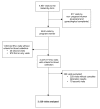Clinical malaria in African pregnant women
- PMID: 18234078
- PMCID: PMC2267805
- DOI: 10.1186/1475-2875-7-27
Clinical malaria in African pregnant women
Abstract
Background: There is a widespread notion, based on limited information, that in areas of stable malaria transmission most pregnant women with Plasmodium falciparum infection are asymptomatic. This study aim to characterize the clinical presentation of malaria in African pregnant women and to evaluate the adequacy of case management based on clinical complaints.
Methods: A hospital-based descriptive study between August 2003 and November 2005 was conducted at the maternity clinic of a rural hospital in Mozambique. All women attending the maternity clinic were invited to participate. A total of 2,330 women made 3,437 eligible visits, 3129 were analysed, the remainder were excluded because diagnostic results were unavailable or they were repeat visits. Women gave a standardized clinical history and had a medical exam. Malaria parasitaemia and haematocrit in capillary blood was determined for all women with signs or symptoms compatible with malaria including: presence and history of fever, arthromyalgias, headache, history of convulsions and pallor. Outcome measure was association of malaria symptoms or signs with positive blood slide for malaria parasitaemia.
Results: In 77.4% of visits pregnant women had symptoms suggestive of malaria; 23% (708/3129) were in the first trimester. Malaria parasitaemia was confirmed in 26.9% (842/3129) of visits. Headache, arthromyalgias and history of fever were the most common symptoms (86.5%, 74.8% and 65.4%) presented, but their positive predictive values for malaria parasitaemia were low [28% (27-30), 29% (28-31), and 33% (31-35), respectively].
Conclusion: Symptoms suggestive of malaria were very frequent among pregnant women attending a rural maternity clinic in an area of stable malaria transmission. However, less than a third of them were parasitaemic. In the absence of microscopy or rapid diagnostic tests, a large proportion of women, including those in the first trimester of gestation, would be unnecessarily receiving antimalarial drugs, often those with unknown safety profiles for pregnancy. Accessibility to malaria diagnostic tools needs to be improved for pregnant women and drugs with a safety profile in all gestational ages are urgently needed.
Similar articles
-
Malaria in pregnancy in rural Mozambique: the role of parity, submicroscopic and multiple Plasmodium falciparum infections.Trop Med Int Health. 2002 Jan;7(1):19-28. doi: 10.1046/j.1365-3156.2002.00831.x. Trop Med Int Health. 2002. PMID: 11851951
-
Malaria in pregnancy in an area of stable and intense transmission: is it asymptomatic?Trop Med Int Health. 2008 Aug;13(8):1016-21. doi: 10.1111/j.1365-3156.2008.02111.x. Epub 2008 Jul 8. Trop Med Int Health. 2008. PMID: 18631316
-
Clinical signs and symptoms cannot reliably predict Plasmodium falciparum malaria infection in pregnant women living in an area of high seasonal transmission.Malar J. 2013 Dec 27;12:464. doi: 10.1186/1475-2875-12-464. Malar J. 2013. PMID: 24373481 Free PMC article.
-
Malaria parasite infection during pregnancy and at delivery in mother, placenta, and newborn: efficacy of chloroquine and mefloquine in rural Malawi.Am J Trop Med Hyg. 1996;55(1 Suppl):24-32. doi: 10.4269/ajtmh.1996.55.24. Am J Trop Med Hyg. 1996. PMID: 8702034 Clinical Trial.
-
A systematic review and meta-analysis of asymptomatic malaria infection in pregnant women in Sub-Saharan Africa: A challenge for malaria elimination efforts.PLoS One. 2021 Apr 1;16(4):e0248245. doi: 10.1371/journal.pone.0248245. eCollection 2021. PLoS One. 2021. PMID: 33793584 Free PMC article.
Cited by
-
Performance of Paracheck™-Pf, SD Bioline malaria Ag-Pf and SD Bioline malaria Ag-Pf/pan for diagnosis of falciparum malaria in the Central African Republic.BMC Infect Dis. 2014 Feb 26;14:109. doi: 10.1186/1471-2334-14-109. BMC Infect Dis. 2014. PMID: 24568311 Free PMC article.
-
In vitro growth of Plasmodium falciparum in neonatal blood.Malar J. 2014 Nov 18;13:436. doi: 10.1186/1475-2875-13-436. Malar J. 2014. PMID: 25406504 Free PMC article.
-
Prevalence of clinical malaria and associated symptoms in pregnant women at Hamusit health center, Northwest Ethiopia.Heliyon. 2024 Jul 8;10(14):e34240. doi: 10.1016/j.heliyon.2024.e34240. eCollection 2024 Jul 30. Heliyon. 2024. PMID: 39816346 Free PMC article.
-
Local illness concepts and their relevance for the prevention and control of malaria during pregnancy in Ghana, Kenya and Malawi: findings from a comparative qualitative study.Malar J. 2013 Jul 22;12:257. doi: 10.1186/1475-2875-12-257. Malar J. 2013. PMID: 23876079 Free PMC article.
-
Is Malaria an Important Cause of Death among Adults?Am J Trop Med Hyg. 2020 Jul;103(1):41-47. doi: 10.4269/ajtmh.20-0036. Epub 2020 Apr 16. Am J Trop Med Hyg. 2020. PMID: 32314692 Free PMC article.
References
-
- WHO/AFRO A strategic framework for malaria prevention and control during pregnancy in the African region. 2004. AFR/MAL/04/01.
-
- Steketee RW, Nahlen BL, Parise ME, Menendez C. The burden of malaria in pregnancy in malaria-endemic areas. Am J Trop Med Hyg. 2001;64:28–35. - PubMed
-
- Steketee RW, Wirima JJ, Slutsker L, Heymann DL, Breman JG. The problem of malaria and malaria control in pregnancy in sub-Saharan Africa. Am J Trop Med Hyg. 1996;55:2–7. - PubMed
Publication types
MeSH terms
LinkOut - more resources
Full Text Sources
Medical


